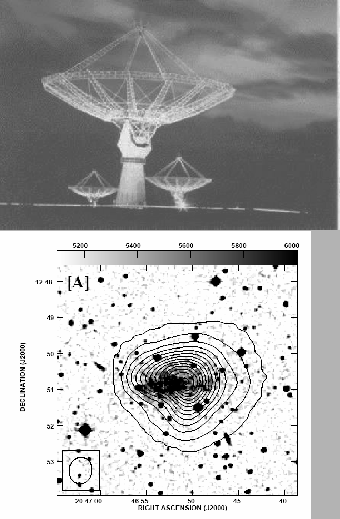



Next: Cosmic Microwave Background Radiation.
Up: Radiowave and Microwave
Previous: Radiowave and Microwave
Contents
Hydrogen is the most abundant element in the universe. Atomic neutral
hydrogen, has two states, one where the proton and electron spins are
aligned and another where they are opposite as shown in
Figure 9.2. The separation between these two energy states
is known as hyperfine splitting in hydrogen. A
transition between these two states causes radiation at
 or
or  to be emitted. This is a very important source of
information about our
Galaxy and external galaxies, neutral hydrogen being found in many
galaxies including our own. The Giant Meterwave
Radio Telescope (GMRT ,Figure 9.3) located in Narayangaon
near Pune is currently the
worlds largest low frequency radio telescope operating in several
frequency bands from
to be emitted. This is a very important source of
information about our
Galaxy and external galaxies, neutral hydrogen being found in many
galaxies including our own. The Giant Meterwave
Radio Telescope (GMRT ,Figure 9.3) located in Narayangaon
near Pune is currently the
worlds largest low frequency radio telescope operating in several
frequency bands from
 to
to
 . Figure
9.3 also shows the image of a dwarf galaxy DDO210 made with the
GMRT using the
. Figure
9.3 also shows the image of a dwarf galaxy DDO210 made with the
GMRT using the  radiation from neutral hydrogen. The
contours show how the neutral hydrogen is distributed while the
distribution of stars is shown in black. It is clear that the
hydrogen gas which is referred to as the interstellar medium is spread
out over a much larger region compared to the stars.
radiation from neutral hydrogen. The
contours show how the neutral hydrogen is distributed while the
distribution of stars is shown in black. It is clear that the
hydrogen gas which is referred to as the interstellar medium is spread
out over a much larger region compared to the stars.
Figure 9.2:
Hyperfine splitting in neurtral hydorgen
 |
Figure 9.3:
GMRT and radio image of a dwarf galaxy
 |




Next: Cosmic Microwave Background Radiation.
Up: Radiowave and Microwave
Previous: Radiowave and Microwave
Contents
Physics 1st Year
2009-01-06
